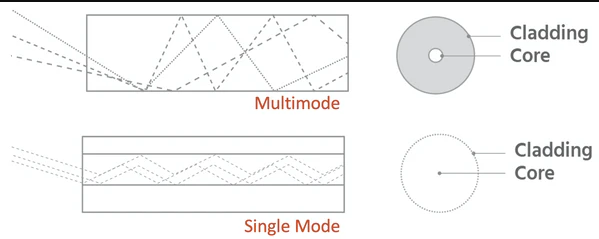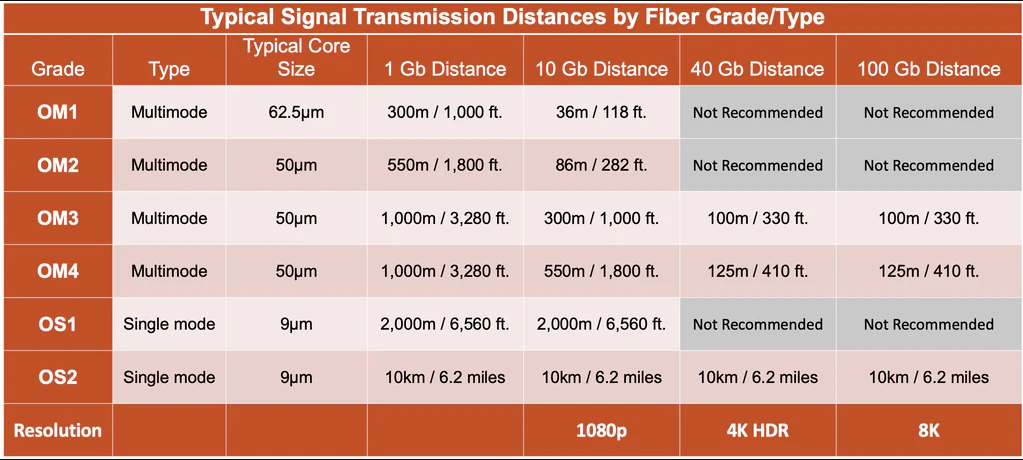

 Knowledge Base +
Knowledge Base +  2024.01.12
2024.01.12I see that my previous response may have caused confusion. I'd like to clarify that the term "faster" in the context of SMF (Single-Mode Fiber) being faster than MMF (Multi-Mode Fiber) might be misleading. Let's address the differences in a more accurate way:
Data Rate and Distance: SMF is often associated with longer-distance transmissions and is commonly used in applications requiring higher data rates over extended distances. SMF can support higher data rates, but the speed of data transmission is not inherently faster; it depends on the specific equipment and technology used.
Modal Dispersion: MMF can suffer from modal dispersion, where different light modes travel at different speeds, limiting the achievable bandwidth and data rates over longer distances. SMF, with its single mode of propagation, does not suffer from modal dispersion and is better suited for longer-distance transmissions.
Wavelengths and Light Sources: SMF typically uses laser light sources with a narrower wavelength, allowing for higher data transmission rates. MMF often uses LED light sources with a broader wavelength spectrum, limiting the achievable data rates compared to SMF.
In summary, while SMF is often chosen for higher-speed and longer-distance applications, it's essential to understand that the term "faster" should be associated more with its ability to support higher data rates over extended distances rather than a direct comparison of transmission speed. The choice between SMF and MMF depends on factors such as distance requirements, data rates, and the specific characteristics of the network.
What's the difference between single mode and multimode fiber?
First the basics.... single mode fiber is designed to propagate a single light mode whereas multimode supports multiple simultaneous light modes. This difference impacts bandwidth, signal transmission distance and signal stability which we'll explore later.
Additionally, single mode and multimode cables are built differently. The optical core in a single mode cable is 9µm and the optical core in a modern multimode cable is 50µm, though older fiber cables (specifically OM1 rated cables) features a 62.5µm core.

The smaller core size in single mode leads to lower attenuation and therefore longer transmission distances and higher bandwidths. The physics are straight forward: a smaller pipe means less signal reflection.

If bandwidth is important to you -- and it should be -- single mode is the clear winner. Single mode cables support brighter, more power light sources with lower attenuation. Plus, a single light mode provides theoretically unlimited bandwidth.
Multimode, on the other hand, relies on the transmission of multiple light modes with less brightness and higher attenuation. This caps the bandwidth and leads to five grades of multimode fiber each with difference bandwidth and distance capabilities. The industry generally ranks the cable and network electronics as follows:

Fiber transmission distance is largely dependent on the electronics and their light output, but in practice we find single mode also outperforms multimode. Single mode fiber supports short distance transmission and long distance transmission regardless of signal bandwidth and/or resolution (such as 1080p, 4K and 8K video). Most electronics will transmit up to 10km (6.2 miles) over a standard single mode cable.
Multimode, on the other hand, has a much shorter maximum transmission distance that's affected by cable grade as indicated in the above chart. We typically find the max distance between 300m - 550m (1,000 - 1,800 feet).
Subscribe to the newsletter
for all the latest updates.
2-5# Building, Tongfuyu Industrial Zone, Aiqun Road, Shiyan Street, Baoan District, Shenzhen. China
